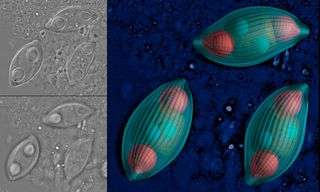New Parasite Discovered; Infects Waterfowl, Other Species

Microbiologists at Oregon State University have discovered a new species of “myxozoan” parasite that has been found for the first time to infect a warm blooded animal – in this case, ducks - after evolving from its relatives that are common in cold-blooded fish and aquatic worms.
It’s unclear how long this parasite has existed or how much of a problem it may ultimately cause, but so far it has only been found in a few places in the United States, experts say.
The findings were just reported in the International Journal for Parasitology, and raise concerns not only about the new parasite but about others that may become more widespread, cause more health problems or possibly even move into new species as a result of global warming and climate change.
“This is pretty unusual to see a parasite group in a completely new host,” said Jerri Bartholomew, an associate professor of microbiology at OSU. “We still need more study and data before we can predict how big of a problem it might become, how it evolved or how many species it ultimately may infect.”
New hosts often have little resistance to new parasites, researchers say, and the new species “Myxidium anatidum,” which appears to target the liver in animals, has already caused mortality in ducks. It was first isolated, in fact, from a duck that had died of unknown cause in a Southern California zoo. Other isolated cases have now been found in Northern California, Texas, Georgia, Florida and elsewhere.
Myxozoa are a group of microscopic, parasitic animals that live in marine and freshwater aquatic habitats, and one or more species are found in virtually all fish. These spore-forming, multicellular parasites had been believed to be exclusively confined to cold-blooded vertebrates and invertebrates. Their effects are sometimes almost completely benign, sometimes cause mild health issues, and sometimes can be fatal. The deadly “whirling disease” in salmon and trout is a myxosporean parasite, and it has caused up to 90 percent mortality in some Western U.S. streams. Myxozoan parasites are a particular problem in aquaculture.
“Some of these parasites are very host specific while others have broad ranges, and we don’t know yet where this new species will fit,” Bartholomew said. “But it’s pretty clear it has now moved into warm-blooded animals, which some other research has suggested may include moles, shrews and even humans with compromised immune systems.”
There is no proof that environmental changes have caused the evolution of this new parasite, the researchers say. But experts believe that parasites are going to become increasing problems associated with warmer climate conditions. They may cause more severe problems in species they are already known to infect. Changing conditions could make some species less able to resist infections, and more parasites may become common in biological conditions similar to those of warm-blooded animals.
“We suspect this species has been around for a while, because it already has some geographic dispersal around the country,” said Sascha Hallett, an OSU research associate and co-author of the study. “Exactly how long, we just don’t know, and it’s worth noting that it was found in migrating waterfowl that move around a lot. Where it will go from here is also difficult to predict.”
The new study identified nine specific cases of the infection in free-flying native and captive exotic ducks. The new parasite is most biologically similar to a species known to infect amphibians and turtles.
As a result of recent research, myxozoans may be reclassified in the “Cynidaria” phylum, composed of about 11,000 simple animals thought to be exclusively aquatic. The new study implies that “the Cnidaria have undergone a niche expansion that allows the exploitation of warm-blooded terrestrial vertebrates by essentially aquatic animals,” the scientists concluded in their report.
Continued studies will try to identify whether waterfowl are being infected by one or more myxozoan parasites, and learn more about the life cycle of those parasites.
Source: Oregon State University


















